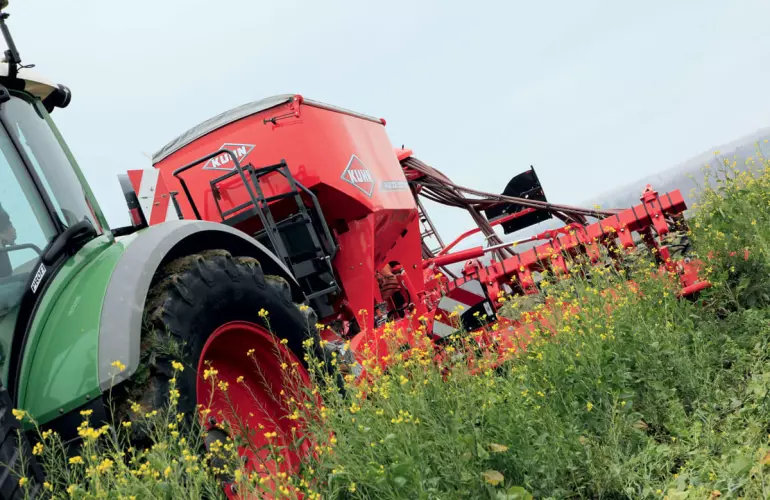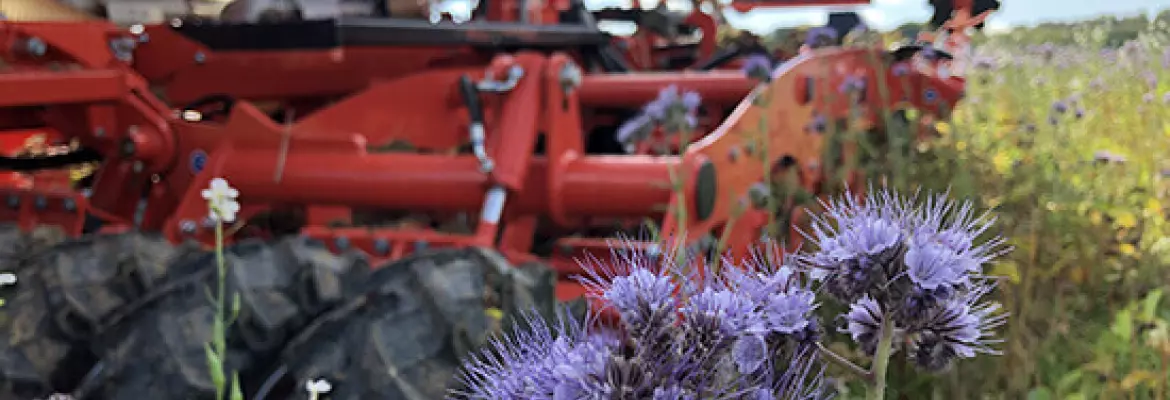
Everything you need to know about cover crops and intercropping practices using cover crops, nitrate-fixing intermediate crops, and intermediate crops.
How do cover crops make soils healthier?
Cover crops are highly beneficial for soil health. They uptake and fix nutrients in the soil, which helps reduce leaching, before releasing the nutrients in the spring. In addition, decomposing cover crops reduce weeds and the need for chemical treatments. Finally, cover crops also limit the risks related to adverse climatic conditions:
- by improve the structure of the soil
- by limiting surface erosion
- by enhancing aeration and water circulation to enable the next crops to develop better
What are the drawbacks of cover crops?
Cover crops can have certain downsides, such as the cost of planting and destruction, as well as competing with main crops for water and nutrient resources. However, the drawbacks can be outweighed by the many benefits for soil health and lower chemical-input requirements. To maximise the benefits, it is important to choose the right species and varieties of cover crops according to the agronomic needs of the farm and take soil-type and climate into account when deciding on planting methods.
What are the positive impacts of cover crops?
Cover crops have 17 positive functions that can be divided into four categories: soil protection, water regulation, biodiversity, and biomass production. Plant cover can help limit erosion, improve soil structure and fertility, reduce nutrient and pesticide leaching, encourage the development of beneficial fauna and flora, and produce biomass for animal feed or energy production.

The 17 beneficial functions of cover crops:
- Protecting against erosion
- Improving soil structure
- Increasing organic matter in the soil
- Reducing nutrient and pesticide leaching
- Sequestering nutrients
- Producing biomass (forage) for animal feed or energy production
- Controlling weeds
- Reducing soil compaction
- Making the soil more porous
- Regulating the amount of water in the soil and reducing flooding and drought risks
- Boosting biodiversity and developing the beneficial flora and fauna for agriculture
- Reducing greenhouse gas emissions by stocking carbon in the soil
- Improving water quality by reducing residual pollution and optimising soil infiltration.
- Protecting against diseases and pests.
- Reducing costs related to chemical inputs.
- Improving the next crop’s yields.
- Contributing to sustainable farming by respecting the environment.
How to grow cover crops successfully?
To ensure the success of your cover crops, you first need to choose the plants best suited to your farm. It's important to think about the most important agronomic needs for your soil-type and climate. It may be necessary to set priorities. The three most commonly used families are crucifers (or brassicas), grasses (sorghum, rye, moha, ryegrass, etc.) and legumes (clover, alfalfa, field pea and field bean). The success of your cover crop depends not only on the species, but also on the cropping system. Therefore, these 5 tips are recommended:
- Know your soil-type and climate
- Define the aims of your cover crop (desired effects)
- Choose complementary species and varieties
- Use mixtures to facilitate plot management
- Look after and regularly check your cover crop
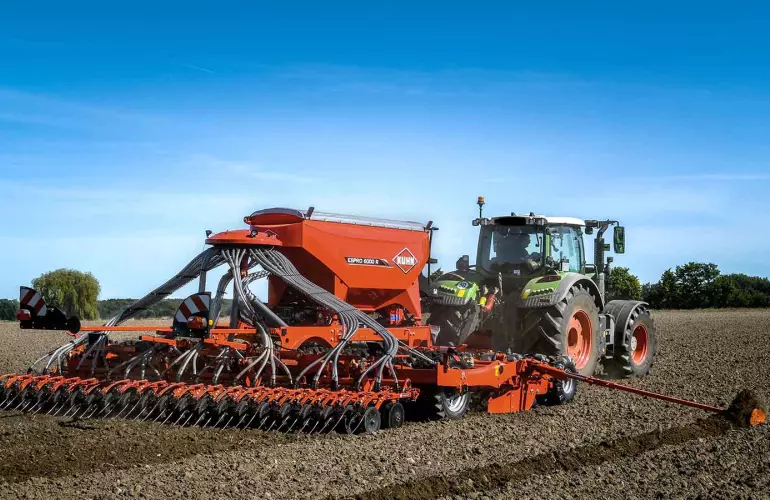
Intercropping with cover crops
Cover crops are often used as part of an " intercropping " system. Intercropping means growing plants between two main crops, generally during the winter or summer. Cover crops are sown after the main crop has been harvested and before the next crop is sown. They cover the soil during the intercropping period, preventing erosion and nutrient loss as well as limiting weeds.
In addition, cover crops contribute to improving soil structure and fertility by adding organic matter and boosting biological activity. Cover crops can also be used to fix nitrates in the soil to limit leaching.
Which techniques are the most effective for planting cover crops?
The most effective techniques for planting cover crops will depend on the farm. For intercrop seeding, a seed drill with discs or tines is recommended for rapid, even planting. For overseeding in an existing crop, it is advisable to plant early to take advantage of soil moisture, and to plant species that take a long time to develop. It is also possible to bury the seeds lightly. Herbicides are not necessary for controlling weeds and regrowth after the crop has been harvested. Finally, it's important to note that the equipment needed for sowing is generally already available on the farm.
Tillage and suitable seeding techniques
Seeding at the same time as the main crop
Sowing at the same time as a main crop can have advantages, such as the soil being moist, and the seedbed being prepared. This enables the cover crop to develop and take root well before weeds can develop. However, it can also have disadvantages, such as competition between the cover crop and the main crop, which can hinder the development of them both.
Overseeding an established crop
Overseeding an established crop has a number of advantages and disadvantages. Advantages include early planting to take advantage of soil moisture, planting species that take a long time to establish, and limiting the development of weeds and regrowth after the crop has been harvested. What's more, the equipment needed for overseeding generally already exists on the farm.
In terms of the drawbacks of overseeding, it can be difficult to adapt the sowing date and the species, which mustn’t complete too much with the crop or interfere with harvesting. A seedling sown too late in a crop may lack light and fail to develop. In addition, depending on the species, there could be a problem of working-width compatibility with the sprayer tracks.
Examples include forage or seed crops in spring cereals, or legume cover crops (black lentil, common vetch, Alexandria, incarnate and Balansa clovers) in forage maize at the 3-4 leaf stage.
Seeding in mulch during harvest or just before
Seeding in mulch during harvest or just before means sowing the cover crop as early as possible to get the benefit from the moisture in the mulch produced by shredding and spreading the residues during harvest. This is a difficult technique to put into practice, though, as it requires specific equipment, such as a harvester-mounted system. Furthermore, there may be issues of working-width compatibility with sprayer tracks. The technique is mainly possible with small seeds at low application rates.
Seeding after harvest (plot tilled or not)
Post-harvest seeding, with or without tillage, has advantages and disadvantages. On the one hand, it requires no special equipment, and water loss through evaporation is reduced if a direct seeding method is used. What's more, by using seed drills that have hoppers with compartments and separate distribution systems, it is easy to mix species.
On the other hand, the sowing period often coincides with dryer soils, which can make seed placement difficult because there may be large amounts of residues. In addition, if the soil has been tilled, there may already be regrowth. Mixed cover crops can be used for seeding after harvest.
Choosing the cover crop species
The species should be chosen to meet the most important agronomic needs for your soil-type and climate, so it is essential to know them and to define the aims of your cover crop (desired effects). It may be necessary to set priorities. The choice of species must take the cropping system into account. It is also recommended to use complimentary species and varieties as well as mixtures that facilitate plot management. By following these tips, you can make the right choice for your cover crops.
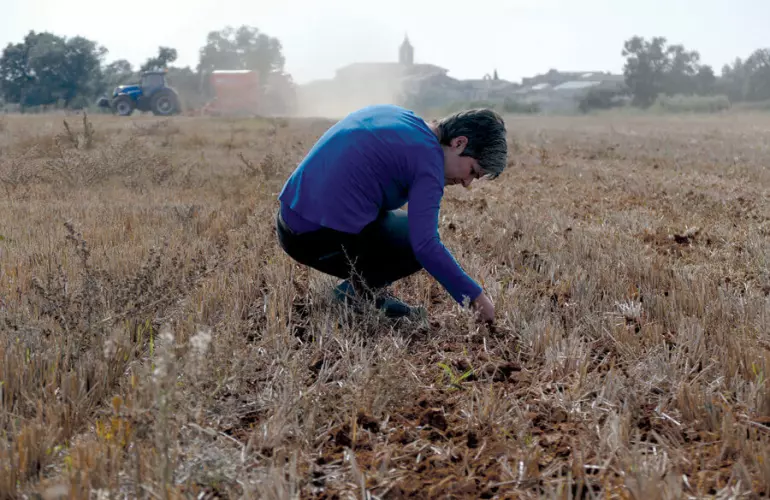
Cover crops or Nitrate-Fixing Intermediate Crops?
The term Nitrate-Fixing Intermediate Crop was coined in the 2000s following the European Nitrate Directive of 1991. The aim of this directive was to reduce water pollution caused by nitrates from agricultural, especially by trapping nitrates in the soil. Nitrate-Fixing Intermediate Crops are cover crops specifically chosen for their nitrate-fixing capacity which reduces leaching into groundwater and surface water. Rye and hairy vetch are examples of typically used Nitrate-Fixing Intermediate Crops.
CIVE aka Biofuel-Producing Cover Crops
CIVE comes from the French "Culture Intermédiaire à Vocation Energétique" (Biofuel-Producing Cover Crops). It is an intermediate crop that is planted and harvested between two main crops in a crop rotation. Unlike Nitrate-Fixing Intermediate Crops, which are primarily used to fix nitrates in the soil, CIVEs are grown for their energy potential. As such, they can be used in an agricultural methanization unit to produce biogas, thereby contributing to the diversification of renewable energy sources, and reducing fossil-fuel dependence.
Green manures
Green manure is an intermediate crop whose purpose is to supply the following crop with nitrogen, as well as to improve soil structure. Cover crops used as green manures are generally legumes, which can trap atmospheric nitrogen and return it to the soil. Green manure contributes to improving soil fertility and reduces the need for chemical fertilisers.
Other species such as crucifers (white mustard, fodder radish, fodder rape, etc.) can fix mineral nitrogen in the soil, limiting nitrogen leaching. This reduces the C/N ratio, which in turn leads to faster residue mineralisation, so that nitrogen is available rapidly for the next crop.
Fixing atmospheric nitrogen
Legumes are known for their capacity to efficiently fix atmospheric nitrogen. This symbiotic nitrogen fixing is a biological process that occurs due to the specific bacteria in the roots of legumes. The capacity of legumes to fix atmospheric nitrogen can be used to improve soil fertility and reduce the need for nitrogen fertilisers.
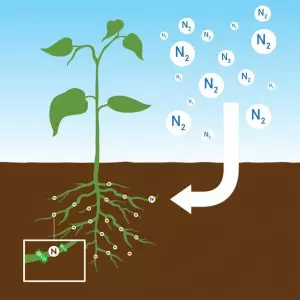
What about destroying cover crops?
Cover crops can be destroyed in different ways, such as shredding, burying, or using herbicides. It is important to choose a method in line with the farm's agronomic and environmental objectives. For example, if you want to avoid using herbicides, you can opt for mechanical or natural destruction (by frost). In addition, to prevent competition with the main crop and limit nutrient leaching, the cover crop needs be destroyed at the right time. Lastly, the cost of destruction and environmental impacts should also be considered when choosing the method most adapted to your farm.
